Liquid Nitrogen Temperature and Facts
Liquid nitrogen (LN) is a cryogenic liquid with temperature of -196°C (− 320 °F). It is generated through compression and cooling nitrogen to an extreme low temperature below its evaporation point of -196°C (− 320 °F). LN is used in many industrial and scientific applications including in food & processing and for preserving biological samples. There are many techniques for producing it for various uses. The most efficient and popular technique is called cryogenic distillation. Other processes such as pressure swing adsorption (PSA) are less efficient and therefore are not popular for efficiency. Industries use LN plants for meeting their LN requirements.

Cryogenic distillation process starts with the intake of atmospheric air. It is then filtered and compressed in the compressor.The feed air is then moved into a purification unit where impurities like moisture, hydrocarbons and carbon dioxide. The air so cleaned passes into heat exchanger where it is cooled to the cryogenic temperature.Here, the liquefied air goes into a high pressure distillation column where air is separated into its constituent parts, oxygen and nitrogen. It is then further distilled in the low pressure column to achieve commercial purity specifications.
Salient Points of
Liquid Nitrogen
- LN is made up of pure nitrogen molecules (N2) in liquid state.
- Liquid nitrogen is colorless.
- At normal temperature, we observe nitrogen liquid below −195.8° C and solid at −209.86 °C.
- Liquid nitrogen is denoted as LN, LIN and LN2.
- At normal temperature, LN boils at −195.8° C.
Liquid Nitrogen Facts
- Liquid nitrogen is produced by cryogenic distillation of liquid air. It is made up of two nitrogen atoms sharing covalent bonds (N2).
- It is inert and quite non-flammable.
- Nitrogen has liquid-to-gas expansion ratio of nitrogen of 1:694.
- At room temperature, nitrogen is lighter than air. It is also soluble in water.
- LN2 was first liquefied by Polish physicists Zygmunt Wróblewski and Karol Olszewski on April 15, 1883.
- It is stored in liquid nitrogen storage tanks and are vented to prevent pressure buildup. It can be stored for weeks even longer depending upon the designing of the cryogenic tanks. ·

LN2 has got many applications in various industries as well as scientific endeavors. Its applications are based on the cold temperature and low reactivity. Some of the important applications include:
- Freezing of food products for storage and transportation.
- Cryopreservation of biological materials including sperm, eggs, etc.
- It is used as a coolant in vacuum pumps, superconductors and other materials.
- It is applied in cryosurgery for removing skin abnormalities.
- It protects materials from oxygen exposure.
- It is a source of dry nitrogen gas.
- LN also finds application in cattle branding.
- Preparing foods and beverages including ice-cream and beer.
- It finds extensive applications in machining or fracturing.·
Liquid Nitrogen
Safety
Working with liquid nitrogen is risky so taking certain precautions is very important. Contact of living tissue with LN2 can cause frostbite. It is imperative that you wear proper safety gear covering & insulating to avoid exposure.Moreover, drinking LN2 can be very dangerous. It goes without saying that it can freeze the tissues but the real damage is from rapid expansion from liquid into a gas. It can tear apart the gastrointestinal tract.It is very important that you observe safety protocols properly.
LN2 temperature and facts play an important role in the use of LN2 in industries which is generated through a LN2 plant.
Post Your Ad Here
Comments